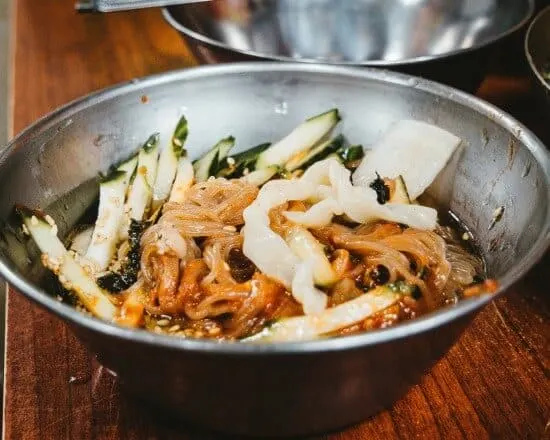If you’re just starting out your journey with kimchi, you surely have a lot of questions. When you search for information on shelf life, the answers are all over the place, ranging between 6 months to virtually indefinite. The best way to store it isn’t clear either, as some recommend keeping it in the fridge, while others say you can leave it in the pantry. What is going on here?
Well, when it comes to how long you can keep kimchi around, and how you should store it, it all depends on how you like it, and when you’re going to consume it. So it’s pretty much impossible to give a short answer without providing more context. And in this article, we’re going to talk exactly about that: shelf life, storage, and spoilage of kimchi, in detail. If that’s what you’re interested in learning more about, keep reading.

Can Kimchi Go Bad? How To Tell If Kimchi Is Bad?
Of course, kimchi can go bad, but if you take good care of it, it can last months past the date on the label, or even years. But before we talk about possible signs of spoilage, let’s first cover some situations when some people think kimchi has gone off, but it hasn’t:
- Bubbly kimchi after opening is perfectly normal. It’s a living thing that’s sometimes more active, hence more fizziness ([SG]).
- Kimchi that explodes upon opening is nothing unusual too. The gas buildup by the fermentation might cause the jar to overflow, just like champagne does ([MIL]).
- A bulging cap can happen every now and then, for precisely the same reasons as above. If it does, make sure you take extra care when opening the jar ([KK]).
- Kimchi turns very sour if you keep it for an extended period at room temperature. It’s safe to eat, but you might prefer to add it to a soup, a stew, or add other veggies instead of eating it raw.
- If you keep the kimchi stored for a long time, you might find that the cabbage has turned soft. It’s perfectly okay to consume, but if you don’t like your kimchi with wilted cabbage, try using it in a recipe.
When it comes to how to tell if your kimchi is spoiled, let’s talk about visual signs. If there’s mold or white film on top, there are two way to go about it. First, you might scoop out the bad part (and then some) from the top, and eat the rest that was covered in liquid/sauce. Or you can err on the side of caution, and discard it whatsoever. It’s up to you, really, but when in doubt, go with the safer solution.
When it comes to other changes, that is altered flavor or smell, if it’s more sour than usual, that’s alright. It’s the result of ongoing fermentation. But if either of these has turned “funny,” or “off,” or there’s something wrong about the kimchi, discard the product. Long story short, humans are pretty good at noticing that food isn’t safe for consumption, so if you spider senses are tingling, listen to them.

How Long Does Kimchi Last?
As I mentioned in the intro, there isn’t one straightforward answer. If you asked a Korean kimchi veteran (kimchi has originated in Korea and is a staple there ([WIKI])) about the shelf life of the product, he or she would probably say that it doesn’t go bad, just gets old ([SG]). That means you can keep it for years if you take good care of it. But just like with unpasteurized sauerkraut, kimchi won’t taste exactly the same forever, quite on the contrary.
Kimchi is basically seasoned and fermented veggies. It’s (typically) not pasteurized, so all of the bacteria in there are alive. And that means the product ferments all the time ([SG]). Ongoing fermentation causes the kimchi to turn sourer over time.
That’s where the date on the label comes into play. In most cases, it’s there to indicate for how long the kimchi should taste great, and not turn overly sour. So if you don’t like it that acidic, make sure you eat it fairly fresh. But if super sour kimchi is your thing, feel free to keep it for an extended period.
Time isn’t the only variable in the equation, though. Temperature affects how sour kimchi becomes, too. In short, the warmer the temperature, the faster the fermentation. So if you buy a fresh jar of kimchi, and put it in your fridge right away, it will be less sour that if you would’ve kept it at room temperature until opening.
As you can see, this topic is a bit tricky, and it’s impossible to give a brief answer to a question like “how long does kimchi last in the fridge after opening?”. It depends on too many factors, like how long did you store it before opening, at what temperature, and how sour kimchi is acceptable to you. In other words, you need to figure this out for yourself, based on your preferences and the kimchi you buy or make. If you’re looking for some rough estimates, the kimchi should taste okay for between 6 and 12 months after opening, provided it’s refrigerated and weren’t very sour once opened.
Last but not least, let’s talk storage.

How To Store Kimchi?
Okay, you already know how storage temperature affects this Korean staple. So when it comes to unopened kimchi, the pantry and the fridge are both solid options, depending on your preferences and how long the jar will stay unopened. When in doubt, refrigerate it.
If you open it up and it’s not sour enough, leave it at room temperature for a day or two, until it reaches your desired taste ([KK]).
Once you open the jar, it’s usually best to store it in the fridge to keep the fermentation in check ([MIL]).
As usual, keep the jar closed when not in use, and make sure to use clean utensils when scooping the veggies. Even though the acidic environment makes it difficult for any bacteria (other than those that are already there) to grow in there, it’s best not to take any chances. And just like with sauerkraut and pickles, make sure to keep everything below the level of the sauce/liquid. This way, the top portion won’t dry out and possibly start to spoil.
Summary
- Kimchi is a living food where fermentation that turns the product sourer is ongoing. The warmer the storage temperature, the faster the fermentation.
- You can store unopened kimchi at room temperature or in the fridge, depending on whether you like it more or less acidic.
- Once you open the container, it’s generally best to refrigerate it, to keep the fermentation in check.
- If kimchi is not sour enough for your taste upon opening, leave it (sealed) for a day or two at room temperature